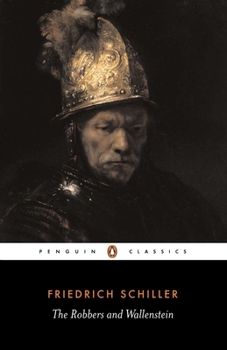The Robbers and Wallenstein
Select Format
Select Condition 
Book Overview
Friedrich Schiller (1759-1805) was one of the most influential of all playwrights, the author of deeply moving dramas that explored human fears, desires and ideals. Written at the age of twenty-one,... This description may be from another edition of this product.
Format:Paperback
Language:English
ISBN:0140443681
ISBN13:9780140443684
Release Date:February 1980
Publisher:Penguin Group
Length:480 Pages
Weight:0.69 lbs.
Dimensions:1.1" x 5.1" x 7.8"
Age Range:18 years and up
Grade Range:Postsecondary and higher
Customer Reviews
2 ratings
The rough broom of war
Published by Thriftbooks.com User , 14 years ago
I have reviewed The Robbers separately in another edition, so I am going to focus on Wallenstein here. Schiller had written a history of the 30 Years War in Germany (1618 to 48). One of the side products of that work was the drama trilogy about Wallenstein, the Bohemian leader of the Catholic (and Austrian) Kaiser's armies in the war against Gustav Adolf, the Swedish patron of German Protestantism. The drama is standard fare on German stages. Its first part was first staged in 1798, while the complete trilogy was published in 1800, after a work process of 10 years. The play is largely based on history, but takes some freedom with facts, eg adds persons that are not historical. The main plot is about loyalty and betrayal, which is another departure for Schiller, who was previously more interested in hot emotions and starry eyed idealism. Wallenstein is a successful military leader and becomes too popular for the emperor's taste. Attempts are made to split his following and to reduce his command: divide and rule. He learns about these efforts to undermine him and starts his own initiatives, exploring possibilities to change sides and ally himself with the Swedes (whose king is not alive any more by now) against the emperor. He loses the political game and gets assassinated. For historical background I recommend three quite different books: The magnificent Wallenstein biography by Thomas Mann's son Golo. The equally magnificent `picaresque' novel Simplicius Simplicissimus by Jakob Grimmelshausen, a contemporary of the 30 Years War. For dessert: Guenter Grass, Das Treffen in Telgte, a short novel about a writers' meeting (a 17th century PEN conference?) near the location of the peace agreement of 1648. The trilogy's parts are of uneven size and content. Part 1 focuses on the army camp and lets us listen to the `people', including the local populace who is not enchanted with being subject to plundering by the troops. We learn that Wallenstein is popular with his soldiers and that all kinds of rumors are beginning to travel about. He is said to have a pact with the devil, a common habit in Germany. He is suspected of not giving a damn when the Protestant armies occupy critical parts of Bavaria. The church is suspicious about his religious allegiances --- does he care at all about religion? One fact was that W listened to astrologers. This may have been a decisive weakness, it may have made him inefficient in critical moments. Part 2 is called The Piccolomini, about a historical rival of Wallenstein's, Octavio Piccolomini, and his fictive son Max, who is an engine of the plot. He has to provide the human interest via an affair with W's daughter. A stage play only about politics wouldn't have worked. Max is torn between his father and his prospective father in law. The emperor wants to transfer part of W's power to Octavio P as a balance to W's strength. W resists. This part is about political intrigue. Politics are like a board game. Popularity i
Wallenstein is a Masterpiece
Published by Thriftbooks.com User , 18 years ago
The Wallenstein trilogy is a fascinating work, constructed in an unusual and innovative manner, and marked by unusually powerful language. Wallenstein is a profoundly ambiguous figure. Was he a proto-German nationalist? A seeker of peace and religous moderation? A determined schemer aiming to develop his own Empire? Some combination of all of these? Schiller, who taught history and was the author of a history of the Thirty Years War, seems to have had the same difficulties in defining Wallenstein as everyone else. To approach Wallenstein, Schiller uses an indirect and very creative method. While Wallenstein is the central figure of the trilogy, he is hardly on stage in the first 2 plays, Wallenstein's Camp and The Piccolomini, and even in the last play, Wallenstein's Death, much of the action concerns other characters. Schiller shows Wallenstein by demonstrating his effect on other characters. In the short initial play, Wallenstein's Camp, Schiller presents the common soldiers' attitudes towards Wallenstein. In The Piccolomini, Schiller shows Wallenstein's attributes by dealing with different members of Wallenstein's court, particularly the Piccolomini, father and son officers who struggle with their divided loyalty to Wallenstein and the Emperor. In a brilliant stroke, Schiller makes each of these different characters exemplify a different aspect of Wallenstein's character. In essence, Schiller makes Wallenstein a kind of universal figure exhibiting a huge array of human traits. In the final play, Wallenstein's death, Wallenstein's inability to choose among or reconcile these different aspects leads to a paralysis of decision and his death. This is all presented with superb characterization and powerful language, including Shakespearean-like set piece speechs of considerable poetic power, even in translation.






